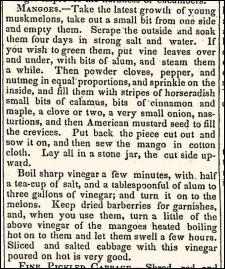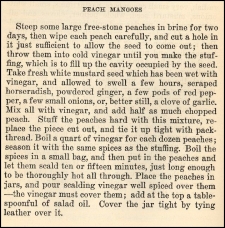Not the fruit, though.
In the bottom of the post for Marshall’s tested pickle recipes, I mentioned that, in the Midwest, the name “mangoes” could sometimes refer to bell peppers in recipes right up to the 1970s.
|
An unripe mango, the type typically used for pickling in the South of India. By Pranav011 on Wikimedia Commons.
|
Green bell pepper by Stacy Spensley, on Flickr |
So, how did it happen? Nobody’s entirely sure, but here’s the most likely theory.
Mango pickles are a familiar condiment across South Asia. While British trade in India began in the 17th century, it intensified after 1757’s Battle of Plassey, where the British East India Company defeated the Nawab of Bengal and the French East India Company to seize the nation as a colony. (The term “British Raj” didn’t exist yet, but functionally, that was the result.)
Along with tea, spices, fabrics, dyes, saltpeter and opium, India’s unique pickles and condiments were brought to the English-speaking world. In North India, an mango pickle with a name usually transliterated as aam ka achaar is made from cubed spiced mangoes that are fermented (a bit like kimchi, but above-ground). In South India, avakai oorugai starts with cut unripe mangoes still in the skin and adds chickpeas and hot spices before being fermented.
Here’s a bit of an advertisement for Indian goods, including pickled goods, from the May 16, 1788 edition of London, England’s Morning Post And Daily Advertiser
|
East and West India Ginger, Sweetmeats and Pickles, Mangoes, Bamboo Achar, Lime Juice, Like Rhob, China and Laque.’d Ware Cordials, Pickles, Oils, Perfumery, &c. much cheaper, and in greater variety than any other house in town, at L[o?]ng’s Warehouse, No. 73, Cheapside.
|
The best theory on what happened next is that, because the mangoes were seen pickled and preserved, the term came to refer to items preserved in the fashion that the mangoes were preserved–fermented in Earthenware crocks (sometimes called “stone jars). At some point thereafter, it came to refer to a specific preparation–something hollowed out and stuffed with spices before being put in the crocks.
This started, really, before we recorded our culinary history. A recipe for melon mangoes appeared in the very first American cookbook, 1796’s American Cookery by Amelia Simmons (this image from the 1798 edition):
|
To pickle or make Mangoes of Melons.
Take green melons, as many as you please, and make a brine strong enough to bear an egg; then pour it boiling hot on the melons, keeping them down under the brine; let them stand five or six days; then take them out, slit them down on one side, take out all the seeds, scrape them well in the inside, and wash them clean with cold water; then take a glove of garlic, a little ginger and nutmeg sliced, and a little whole pepper; put all these proportionably into the melons, filling them up with mustard-seeds; then lay them in an earthen pot with the slit upwards, and take one part of mustard and two parts of vinegar, enough to cover them, pouring it upon them scalding hot, and keep them close topped. |
Here’s a version from the September 25, 1847 edition of the Vevay Indiana Palladium for melon, which is actually excerpted from, and attributed to, the 1846 volume Miss Beecher’s Domestic Receipt Book by Catharine Esther Beecher:
|
Mangoes. — Take the latest growth of young muskmelons, take out a small bit from one side and empty them. Scrape the outside and soak them four days in strong salt and water. If you wish to green them, put vine leaves over and under, with bits of alum, and steam them a while. Then powder cloves, pepper, and nutmeg in equal proportions, and sprinkle on the inside, and fill them with stripes of horseradish, small bits of calamus, bits of cinnamon and maple, a clove or two, a very small onion, nasturtions, and then American mustard seed to fill the crevices. Put back the piece cut out and sew it on, and then sew the mango in cotton cloth. Lay all in a stone jar, the cut side upward.
Boil sharp vinegar a few minutes, with half a tea-cup of salt, and a tablespoonful of alum to three gallons of vinegar; and turn it on to the melons. Keep dried barberries for garnishes, and, when you use them, turn a little of the above vinegar of the mangoes heated boiling hot on to them and let them swell a few hours. Sliced and salted cabbage with this vinegar poured on hot is very good. |
But it wasn’t just melons. For example, here’s a recipe for a filling for cucumber mangoes, from 1873’s Presbyterian Cook Book, Compiled By The Ladies Of The First Presbyterian Church, Dayton, Ohio:
|
Filling For Cucumber Mangoes.
Miss Louie Phillips. One half pound of white mustard seed; one ounce of cloves; one of black pepper; two of celery seed; one cup of horse-radish, grated; one pod of garlic in each cucumber; four tablespoonful of table mustard; eight of oil, and one of turmeric. Mix the mustard in cold water, and boil; when cold, stir in the oil and the turmeric, and then mix with the other ingredients. Onions, cabbage, and tomatoes may be chopped with the filling, if desired. |
And here’s a recipe for peach mangoes, from 1885’s La Cuisine Creole by Lafcadio Hearn:
|
Peach Mangoes
Steep some large free-stone peaches in brine for two days, then wipe each peach carefully, and cut a hole in it just sufficient to allow the seed to come out; then throw them into cold vinegar until you can make the stuffing, which is to fill up the cavity occupied by the seed. Take fresh white mustard seed which has been wet with vinegar, and allowed to swell a few hours, scraped horseradish, powdered ginger, a few pods of red pepper, a few small onions, or, better still, a clove of garlic. Mix all with vinegar, and add half as much chopped peach. Stuff the peaches hard with this mixture, replace the piece cut out, and tie it up tight with pack-thread. Boil a quart of vinegar for each dozen peaches; season it with the same spices as the stuffing. Boil the spices in a small bag, and then put in the peaches and let them scaled 10 or 15 minutes, jus tong enough to be thoroughly hot all through. Place the peaches in jars, and pour scalding vinegar well sided over them–the vinegar must cover them; add at the top a tablespoonful of salad oil. Cover the jar tight by tying leather over it. |
But of course, it was the pepper mangoes that endured the longest, particularly in the Midwest. Here’s a version from 1845’s Domestic Cookery, Useful Receipts, and Hints to Young Housekeepers by Elizabeth Ellicot Lea (the image is from an 1869 printing):
|
Pepper Mangoes.
Take fully grown green peppers, cut a slit in the side of each and take out the seeds; make a strong brine and lay them in it for three days; then soak them in clear water a day and night; pack them in a jar, and pour boiling vinegar over them with a piece of alum; let them stay in this three days, when boil the vinegar again, and pour over them; when they are green, stuff them with chopped cabbage, mustard seed, cloves, horse-radix, pepper, and a small onion in each; tie them up, put them in a jar; boil fresh vinegar and pour over. Observe always to have the kettle you boil vinegar in well cleaned; never put pickles in common earthenware, as the glazing is poisonous. |
Over time, the cabbage-stuffed-fermented green pepper mangoes were simply called “mangoes” in the Midwest, which led to the green peppers themselves being called mangoes.
That results in occasionally encountering recipes that are baffling if you’re not aware of that tidbit. Consider this recipe for a pepper relish from the September 2, 1926 edition of the Hamilton (Ohio) Daily News:
|
Second Prize
Pepper Sauce Relish. 2 dozen red mangoes, 2 dozen green mangoes, 2 red peppers, 3 quarts onions, 3 pints cider vinegar, 6 cups sugar, 4 tablespoons salt. Remove seeds from mangoes, then chop mangoes and onions fine and pour boiling water over them and let stand fifteen minutes and then drain thoroughly. Add sugar, salt, and vinegar and cook 30 minutes and seal tight.
Mrs. Louis Reiter,
615 Millville avenue, Hamilton, Ohio. |
From the box of A.D. from Lutz, Florida, by way of Pennsylvania in the 1940s, and originating in Ohio in the 1920s.
Mangoes
Select large sweet mangoes, cut off top and remove seeds, let stand in weak brine overnight then drain. Fill with finely chopped cabbage seasoned with 1 Tbsp. salt, 1 Tbsp. celery seed to each quart of cabbage. Lie tops on peppers, place in stone jars and pour boiling vinegar over them. Let stand 2 weeks, then pour off vinegar and pour on fresh vinegar.










